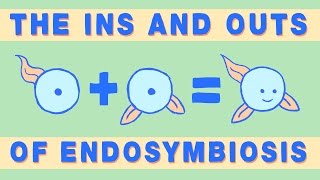(单词翻译:单击)
What if you could absorb another organism and take on its abilities?
如果你能吸收其他生物,然后因此得到它所具有的能力,这听起来怎么样?
Imagine you swallowed a small bird and suddenly gained the ability to fly.
想像你吞下一只小鸟,并突然得到飞的能力。
Or if you engulfed a cobra and were then able to spit poisonous venom from your teeth.
或者如果你吞下一条眼镜蛇,就能够吐出毒液。
Throughout the history of life, specifically during the evolution of complex eukaryotic cells,
在生命的历史中,特别是在复杂真核细胞的进化中,
things like this happened all the time.
像这样的事情是经常发生的。
One organism absorbed another, and they united to become a new organism with the combined abilities of both.
一个有机体吞没另一个,它们合二为一,成为一个全新并有组合能力的新有机体。
We think that around 2 billion years ago,
想想大约20亿年前,
the only living organisms on Earth were prokaryotes, single-celled organisms lacking membrane-bound organelles.
地球上唯一存在的有机体是原核生物,这是一种没有膜结合细胞器的单细胞生物。
Let's look closely at just three of them.
让我们仔细看看其中的三种。
One was a big, simple blob-like cell with the ability to absorb things by wrapping its cell membrane around them.
一种是巨大、简单的点状细胞,它们能够把其他有机体包在其细胞膜内。
Another was a bacterial cell that converted solar energy into sugar molecules through photosynthesis.
另一种是细菌,它能透过光合作用将太阳能转化为糖类。
A third used oxygen gas to break down materials like sugar and release its energy into a form useful for life activities.
第三种则是利用氧气将糖类等物质分解,并将一些有助生物活动的能量释放出去。
The blob cells would occasionally absorb the little photosynthetic bacteria.
这些细胞有时也会吞噬小的光合细菌。
These bacteria then lived inside the blob and divided like they always had, but their existence became linked.
这些细菌在细胞内不断分裂,但是它们的存在被连结在一起。
If you stumbled upon this living arrangement, you might just think that the whole thing was one organism,
如果你碰巧遇到它,你可能以为它只是一个有机体,
that the green photosynthetic bacteria were just a part of the blob that performed one of its life functions,
以为这些绿色的光合细菌只是这巨大细胞的一部分,以为它要执行生命机能,
just like your heart is a part of you that performs the function of pumping your blood.
就好像你的心脏也是你的一部分,它将血液运送到全身。
This process of cells living together is called endosymbiosis, one organism living inside another.
这种细胞共存的过程,我们称之为内共生,也就是一个有机体住在另一个有机体内。
But the endosymbiosis didn't stop there.
但共生一事不仅于此。
What would happen if the other bacteria moved in, too?
如果其他细胞也搬进来了会怎样呢?
Now the cells of this species started becoming highly complex.
那么,这样的细胞开始变得极为复杂。
They were big and full of intricate structures that we call chloroplasts and mitochondria.
它们很大且充满复杂的结构,我们称这些为叶绿体和线粒体。
These structures work together to harness sunlight, make sugar,
这些结构能一起利用阳光制造出糖分,
and break down that sugar using the oxygen that right around this time started to appear in the Earth's atmosphere.
并且利用氧气分解糖分,这时也是氧气开始出现在大气层的时候。

Organisms absorbing other organisms was one way species adapted to the changing environmental conditions of their surroundings.
有机体吸收其他有机体是一种生物进行适应周遭环境变化的方式。
This little story highlights what biologists call the endosymbiotic theory,
这个小故事总结了生物学家的内共生理论,
the current best explanation of how complex cells evolved.
这是目前针对复杂细胞如何进化的最好的解释。
There's a lot of evidence that supports this theory, but let's look at three main pieces.
有很多证据支持此理论,但是让我们先看三个主要部分。
First, the chloroplasts and mitochondria in our cells multiply the very same way as those ancient bacteria,
首先,在我们的细胞内,叶绿体和线粒体以非常相同的方式繁殖,就像古代的细菌一样,
which are still around, by the way.
顺道一提它们现在依然存在。
In fact, if you destroy these structures in a cell, no new ones will appear.
事实上,你如果把一个细胞内的这些结构破坏了,细胞并不会产生新的结构。
The cell can't make them. They can only make more of themselves.
它们并不能制造这些结构,这些细胞只能繁殖。
Second piece of evidence.
第二个证据。
Chloroplasts and mitochondria both contain their own DNA and ribosomes.
叶绿体和线粒体都有自己的DNA和核糖体。
Their DNA has a circular structure that is strikingly similar to the DNA of the ancient bacteria,
它们的DNA都有环状结构,这些结构和古老细菌的DNA有着明显的相似,
and it also contains many similar genes.
并且也包含很多相似的基因。
The ribosomes, or protein assembly machines of chloroplasts and mitochondria,
核糖体,或者是叶绿体和线粒体的蛋白质组成机器,
also have the same structure as ribosomes of ancient bacteria,
也和古代细菌的核糖体有类似的结构,
but are different from the ribosomes hanging around the rest of eukaryotic cell.
但是它们和在细胞的其他地方的核糖体不同。
Lastly, think about the membranes involved in the engulfing process.
最后,想想在这吞噬过程中的细胞膜。
Chloroplasts and mitochondria both have two membranes surrounding them, an inner and outer membrane.
叶绿体和粒线体两者都有两个细胞膜包围,一个是内部细胞膜,一个是外部细胞膜。
Their inner membrane contains some particular lipids and proteins that are not present in the outer membrane.
内部细胞膜含有特别的脂质和蛋白质,这些并不存在外部细胞膜中。
Why is that significant? Because their outer membrane used to belong to the blob cell.
为什么那么重要呢?因为它们的外部细胞膜曾经属于巨大细胞。
When they were engulfed in the endosymbiosis process,
当它们在共生过程中被吞没时,
they got wrapped up in that membrane and kept their own as their inner one.
它们被包在系统膜内,并被保留在它们内部。
Surely enough, those same lipids and proteins are found on the membranes of the ancient bacteria.
能够确定的是,相同的脂质和蛋白质也在古代的细菌细胞膜中找到了。
Biologists now use this theory to explain the origin of the vast variety of eukaryotic organisms.
生物学家用这个理论去解释了很多真核有机体的起源。
Take the green algae that grow on the walls of swimming pools.
比如说长在游泳池墙上的绿藻。
A larger eukaryotic cell with spinning tail structures, or flagella, at some point absorbed algae like these to form what we now call euglena.
有旋转尾部结构或鞭毛的巨大有核系统吸收了绿藻,形成我们现在所谓的绿虫藻。
Euglena can perform photosynthesis, break down sugar using oxygen, and swim around pond water.
绿虫藻可以进行光合作用,利用氧气分解糖,并能在池塘上游泳。
And as the theory would predict, the chloroplasts in these euglena have three membranes since they had two before being engulfed.
用这一理论推测,这个绿虫藻中的叶绿体有三个细胞膜,因为在它们被吞没前已经有两个。
The absorbing process of endosymbiotic theory allowed organisms
这个共生的吸收过程使得有机体
to combine powerful abilities to become better adapted to life on Earth.
组合强大的能力,使它们能更加适应地球生活。
The results were species capable of much more than when they were separate organisms,
结果是生物的种类能够比它们是独立个体时还要多,
and this was an evolutionary leap that lead to the microorganisms, plants, and animals we observe on the planet today.
这是进化的大跃进,使得我们在现在的地球上能够看到微生物、植物以及动物。


